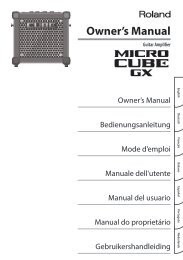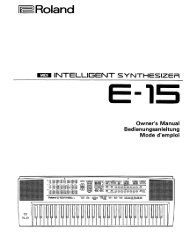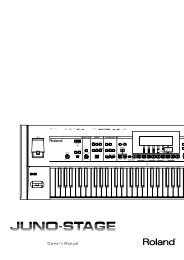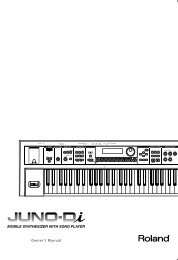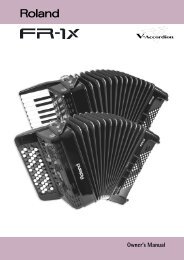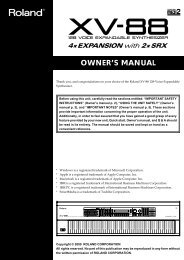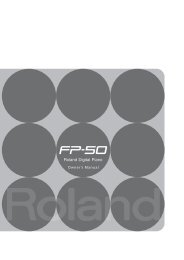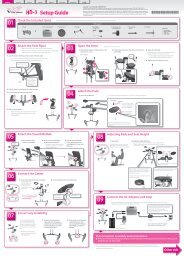Owner's Manual - Roland
Owner's Manual - Roland
Owner's Manual - Roland
Create successful ePaper yourself
Turn your PDF publications into a flip-book with our unique Google optimized e-Paper software.
136<br />
Creating a Performance<br />
With the Fantom VS, you have total control over a wide<br />
variety of settings. Each item that can be set is known as a<br />
parameter. This chapter explains the procedures used in<br />
creating Performances, and the functions of the Performance<br />
parameters.<br />
Adjusting the Parameters of<br />
Each Part<br />
Parameter List<br />
Patch Group<br />
Selects the group to which the desired patch or rhythm set<br />
belongs.<br />
Value<br />
PRA–I: Preset A–I<br />
GM: GM (GM2)<br />
Patch Number<br />
Level<br />
Pan<br />
Selects the desired patch or rhythm set by its number.<br />
Value: 001–<br />
Adjust the volume of each part. This setting’s main purpose is<br />
to adjust the volume balance between parts.<br />
Value: 0–127<br />
Adjust the pan of each part. “L64” is far left, “0” is center, and<br />
“63R” is far right.<br />
Value: L64–0–63R<br />
Solo Switch<br />
Select one part whose sound you want to play. Turn it “SOLO”<br />
to the part that you want to solo. Parts other than the part<br />
you select here will not sound.<br />
Value: –, SOLO<br />
Mute Switch<br />
Mutes (MUTE) or un-mutes (OFF) each part.<br />
Value: OFF, MUTE<br />
Octave Shift<br />
The Mute Switch parameter does not turn the part off,<br />
but sets the volume to minimum so that no sound is<br />
heard. Therefore, MIDI messages are still received.<br />
Adjusts the pitch of the part’s sound up or down in units of<br />
an octave (+/-3 octaves).<br />
Value: -3– +3<br />
Coarse Tune<br />
Note that when a rhythm set is assigned to a part, you<br />
cannot modify the Octave Shift parameter.<br />
Adjusts the pitch of the part’s sound up or down in semitone<br />
steps (+/-4 octaves).<br />
Value: -48– +48<br />
Coarse Tune and Octave Shift<br />
The Coarse Tune and Fine Tune parameters, along with<br />
the Octave Shift parameter, can all be seen as doing the<br />
same thing to the sound, i.e., changing the pitch of the<br />
sound. For example, if C4 (Middle C) is played with the<br />
Coarse Tune parameter set to “+12,” the note produced<br />
is C5 (one octave above C4). For example, if C4 (Middle<br />
C) is played with the Octave Shift parameter set to “+1,”<br />
the note produced is C5 (one octave above C4).<br />
However, internally these function very differently.<br />
When the Coarse Tune parameter is set to “+12,” the<br />
pitch itself is raised one octave. On the other hand,<br />
when the Octave Shift parameter is set to “+1,” it is the<br />
same as pressing the keys one octave up. In other<br />
words, use the Coarse Tune parameter when changing<br />
the pitch, and the Octave Shift parameter when you<br />
want to shift the entire keyboard, for example, when the<br />
number of keys is insufficient.



